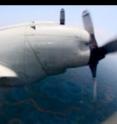New study reveals aerosol plumes downwind of the Deepwater Horizon oil spill
Scientists from the University of Miami (UM) Rosenstiel School of Marine & Atmospheric Science were part of a national research team to find two plumes of oil-based pollutants downwind of the BP Deep Water Horizon oil spill. In a study published in this week's issue of the journal Science, the research team offers new insight into the mechanism by which the crude oil traveled from the sea surface to the atmosphere. The National Oceanic and Atmospheric Administration (NOAA)-led research team collected data of atmosphere gas and aerosol concentrations during two flights, on June 8 and June 10, aboard a specially equipped NOAA WP-3 Orion aircraft.
"By having such a well-defined source of the evaporating oil we were able to investigate how aerosols form in the atmosphere," said UM Rosenstiel School Professor of Marine and Atmospheric Chemistry Elliot Atlas, a co-author of the paper. Atlas regularly uses similar techniques to study aerosol formation and air pollution downwind of major U.S. cities, such as Boston and Los Angeles.
The data revealed that two plumes of hydrocarbons were released into the atmosphere by the surface oil and from the smoke associated with the burning of oil during cleanup efforts. The first was a narrower three-kilometer (1.8-mile) wide hydrocarbon plume downwind of the spill site. The researchers suggest that this was the result of "direct evaporation of fresh oil on the sea surface."
The second, a larger 40-kilometer (24-mile)-wide plume, contained higher concentrations of organic aerosols and was "formed from vapors released from the oil and the condensation of their atmospheric oxidation products onto existing particles," according to the study's authors. The wider oil vapor-based plume contributed to the formation of secondary organic aerosols, which are the result of oil vapor reacting in the atmosphere. The researchers observed that methane and other light hydrocarbons dissolved in the water column, while other, less volatile components of crude oil, made their way to the surface and into the atmosphere.
Claire Paris, a UM Rosenstiel School assistant professor of Applied Marine Physics, and UM Rosenstiel School researcher Matthieu Le Hénaff, in collaboration with Ashwanth Srinivasan of UM's Center for Computational Science produced numerical simulations of the oil spill during and following the airborne measurements by the NOAA-led team.
"These simulations of fresh oil reaching the sea surface and aged oil spreading in a wider area downwind are key to understanding the evaporation processes of more or less volatile hydrocarbon compounds," said Paris, a biophysical modeler. "The model predictions that included oil behavior, advection, and wind drift helped link the measured organic aerosols to their source and mechanism of emission."
UM Rosenstiel School co-investigators Paris, Srinivasan and Meteorology and Physical Oceanography Research Associate Professor Villy Kourafalou were awarded a National Science Foundation RAPID grant in July 2010 to model the three-dimensional dynamics of the oil spill and assess its fate and extent.
This study provides researchers with a more comprehensive understanding of the effects of air pollutants and their secondary chemical products on the environment, human health and global climate change.
"The study also shows the benefit of having the right scientific capabilities available for rapid hazard response," said Atlas, who was part of a research team studying air quality in California that was called in to take air measurements during the oil spill. "It was fortuitous that we were able to get out there quickly with the necessary instruments and expertise, which turned out to be very useful."
Source: University of Miami Rosenstiel School of Marine & Atmospheric Science
Other sources
- Aerosol data from BP spillfrom Chemistry WorldFri, 11 Mar 2011, 9:33:56 UTC
- New study reveals aerosol plumes downwind of the Deepwater Horizon oil spillfrom Science BlogThu, 10 Mar 2011, 23:00:29 UTC
